[PYTHON] 100 Language Processing Knock 2020 Chapter 6: Machine Learning
The other day, 100 Language Processing Knock 2020 was released. I myself have only been in natural language processing for a year, and I don't know the details, but I will solve all the problems and publish them in order to improve my technical skills.
All shall be executed on jupyter notebook, and the restrictions of the problem statement may be broken conveniently. The source code is also on github. Yes.
Chapter 5 is here.
The environment is Python 3.8.2 and Ubuntu 18.04.
Chapter 6: Machine Learning
In this chapter, we will use the News Aggregator Data Set published by Fabio Gasparetti to work on the task (category classification) of classifying news article headlines into the categories of "business", "science and technology", "entertainment", and "health".
Please download the required dataset from here.
The downloaded file shall be placed under data.
50. Obtaining and shaping data
Download the News Aggregator Data Set and create training data (train.txt), verification data (valid.txt), and evaluation data (test.txt) as follows.
- Unzip the downloaded zip file and read the explanation of readme.txt.
- Extract only cases (articles) whose information sources (publishers) are "Reuters", "Huffington Post", "Businessweek", "Contactmusic.com", and "Daily Mail".
- Randomly sort the extracted cases.
- Divide 80% of the extracted cases into training data and the remaining 10% into verification data and evaluation data, and save them with the file names train.txt, valid.txt, and test.txt, respectively. Write one case per line in the file, and use the tab-delimited format of the category name and article headline. After creating the training data and evaluation data, check the number of cases in each category.
Read the dataset from the zip file.
code
import zipfile
code
#Read from zip file
with zipfile.ZipFile('data/NewsAggregatorDataset.zip') as f:
with f.open('newsCorpora.csv') as g:
data = g.read()
#Decode byte sequence
data = data.decode('UTF-8').splitlines()
#Tab delimited
data = [line.split('\t') for line in data]
len(data)
output
422937
Specify the information source and sort at random.
code
publishers = {
'Reuters',
'Huffington Post',
'Businessweek',
'Contactmusic.com',
'Daily Mail',
}
data = [
lst
for lst in data
if lst[3] in publishers
]
data.sort()
len(data)
output
13356
Discard all but the category name and article headline.
code
data = [
[lst[4], lst[1]]
for lst in data
]
Divide into learning / verification / evaluation data. sklearn has a function with a similar function, but it's not as difficult as trying to get into the black box. Just specify the location to cut out and cut.
code
train_end = int(len(data) * 0.8)
valid_end = int(len(data) * 0.9)
train = data[:train_end]
valid = data[train_end:valid_end]
test = data[valid_end:]
print('Training data', len(train))
print('Validation data', len(valid))
print('Evaluation data', len(test))
output
Training data 10684
Validation data 1336
Evaluation data 1336
Save to a file.
code
def write_dataset(filename, data):
with open(filename, 'w') as f:
for lst in data:
print('\t'.join(lst), file = f)
code
write_dataset('../train.txt', train)
write_dataset('../valid.txt', valid)
write_dataset('../test.txt', test)
Check the number of cases for each category.
code
from collections import Counter
from tabulate import tabulate
code
categories = ['b', 't', 'e', 'm']
category_names = ['business', 'science and technology', 'entertainment', 'health']
table = [
[name] + [freqs[cat] for cat in categories]
for name, freqs in [
('train', Counter([cat for cat, _ in train])),
('valid', Counter([cat for cat, _ in valid])),
('test', Counter([cat for cat, _ in test])),
]
]
tabulate(table, headers = categories)
output
b t e m
----- ---- ---- ---- ---
train 4463 1223 4277 721
valid 617 168 459 92
test 547 134 558 97
51. Feature extraction
Extract the features from the training data, verification data, and evaluation data, and save them under the file names train.feature.txt, valid.feature.txt, and test.feature.txt (this file will be reused later in question 70). To do). Write one case per line in the file, and use a space-separated format for category names and article headlines. Feel free to design the features that are likely to be useful for categorization. The minimum baseline would be an article headline converted to a word string.
It seems that tf-idf or word vector can be used, but since the darkness of feature extraction is infinitely deep, I would like to run aground in shallow water. In other words, Bag-of-Words.
code
import re
import spacy
import nltk
Divide it into word strings and make them lowercase and stem.
code
nlp = spacy.load('en')
stemmer = nltk.stem.snowball.SnowballStemmer(language='english')
def tokenize(x):
x = re.sub(r'\s+', ' ', x)
x = nlp.make_doc(x) # nlp(x)Because it runs other than slow tokenizer
x = [stemmer.stem(doc.lemma_.lower()) for doc in x]
return x
code
tokenized_train = [[cat, tokenize(line)] for cat, line in train]
tokenized_valid = [[cat, tokenize(line)] for cat, line in valid]
tokenized_test = [[cat, tokenize(line)] for cat, line in test]
Extract the token to be used as a feature.
code
#Count the frequency of appearance
counter = Counter([
token
for _, tokens in tokenized_train
for token in tokens
])
#Remove high and low frequency words
vocab = [
token
for token, freq in counter.most_common()
if 2 < freq < 300
]
len(vocab)
output
4790
Bi-gram is also a feature. The US and us have become the same due to lowercase letters, but if you include bi-gram, "us stock" will be effective as a feature.
code
bi_grams = Counter([
bi_gram
for _, sent in tokenized_train
for bi_gram in zip(sent, sent[1:])
]).most_common()
bi_grams = [tup for tup, freq in bi_grams if freq > 4]
len(bi_grams)
output
3094
you save.
code
with open('result/vocab_for_news.txt', 'w') as f:
for token in vocab:
print(token, file = f)
code
with open('result/bi_grams_for_news.txt', 'w') as f:
for tup in bi_grams:
print(' '.join(tup), file = f)
All features
code
features = vocab + [' '.join(x) for x in bi_grams]
len(features)
output
7884
Extract the features and save them.
code
import numpy as np
code
vocab_dict = {x:n for n, x in enumerate(vocab)}
bi_gram_dict = {x:n for n, x in enumerate(bi_grams)}
def count_uni_gram(sent):
lst = [0 for token in vocab]
for token in sent:
if token in vocab_dict:
lst[vocab_dict[token]] += 1
return lst
def count_bi_gram(sent):
lst = [0 for token in bi_grams]
for tup in zip(sent, sent[1:]):
if tup in bi_gram_dict:
lst[bi_gram_dict[tup]] += 1
return lst
code
def prepare_feature_dataset(data):
ts = [categories.index(cat) for cat, _ in data]
xs = [
count_uni_gram(sent) + count_bi_gram(sent)
for _, sent in data
]
return np.array(xs, dtype=np.float32), np.array(ts, dtype=np.int8)
def write_feature_dataset(filename, xs, ts):
with open(filename, 'w') as f:
for t, x in zip(ts, xs):
line = categories[t] + ' ' + ' '.join([str(int(n)) for n in x])
print(line, file = f)
code
train_x, train_t = prepare_feature_dataset(tokenized_train)
valid_x, valid_t = prepare_feature_dataset(tokenized_valid)
test_x, test_t = prepare_feature_dataset(tokenized_test)
code
write_feature_dataset('result/train.feature.txt', train_x, train_t)
write_feature_dataset('result/valid.feature.txt', valid_x, valid_t)
write_feature_dataset('result/test.feature.txt', test_x, test_t)
Let's look at an example.
code
import pandas as pd
code
with open('result/train.feature.txt') as f:
table = [line.strip().split(' ') for _, line in zip(range(10), f)]
pd.DataFrame(table, columns=['category'] + features)

52. Learning
Learn the logistic regression model using the training data constructed in> 51.
Use sklearn.
It's as easy as implementing logistic regression with the steepest descent method, but if you try to scratch the quasi-Newton method, your heart will be broken by the Hessian matrix and your heart will break around the linear search, so you will have a heavy mental load on a daily basis. It is not recommended for human beings. This is an experience story, but there is a risk of running an eccentricity such as rolling the aluminum foil and stopping it where the aluminum foil conditions are met. On the other hand, scikit-learn can be used even when sleeping.
code
from sklearn.linear_model import LogisticRegression
code
lr = LogisticRegression(max_iter=1000)
lr.fit(train_x, train_t)
output
LogisticRegression(C=1.0, class_weight=None, dual=False, fit_intercept=True,
intercept_scaling=1, l1_ratio=None, max_iter=1000,
multi_class='auto', n_jobs=None, penalty='l2',
random_state=None, solver='lbfgs', tol=0.0001, verbose=0,
warm_start=False)
You can do it even if you sleep because you can make a model and fit () it. It's very easy.
53. Forecast
Use the logistic regression model learned in> 52 and implement a program that calculates the category and its prediction probability from the given article headline.
code
def predict(x):
out = lr.predict_proba(x)
preds = out.argmax(axis=1)
probs = out.max(axis=1)
return preds, probs
Predicted by training data.
code
preds, probs = predict(train_x)
pd.DataFrame([[y, p] for y, p in zip(preds, probs)], columns = ['Forecast', 'probability'])
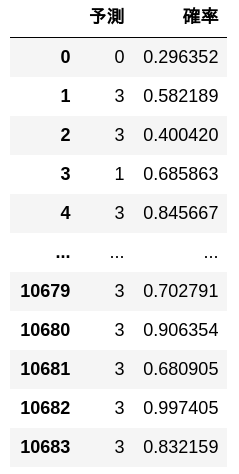
Predicted by evaluation data.
code
preds, probs = predict(test_x)
pd.DataFrame([[y, p] for y, p in zip(preds, probs)], columns = ['Forecast', 'probability'])
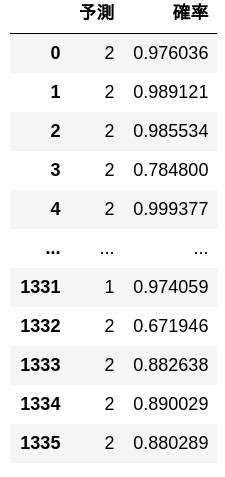
54. Measurement of correct answer rate
Measure the correct answer rate of the logistic regression model learned in> 52 on the training data and evaluation data.
code
def accuracy(lr, xs, ts):
ys = lr.predict(xs)
return (ys == ts).mean()
code
print('Training data')
print(accuracy(lr, train_x, train_t))
output
Training data
0.994664919505803
code
print('Evaluation data')
print(accuracy(lr, test_x, test_t))
output
Evaluation data
0.906437125748503
55. Creating a confusion matrix
Create a confusion matrix of the logistic regression model learned in> 52 on the training data and evaluation data.
You will be happy if you use seaborn. I think c in the confusion matrix is the sea of sea born.
code
import seaborn as sns
code
def confusion_matrix(xs, ts):
num_class = np.unique(ts).size
mat = np.zeros((num_class, num_class), dtype=np.int32)
ys = lr.predict(xs)
for y, t in zip(ys, ts):
mat[t, y] += 1
return mat
def show_cm(cm):
sns.heatmap(cm, annot=True, cmap = 'Blues', xticklabels = categories, yticklabels = categories)
code
train_cm = confusion_matrix(train_x, train_t)
print('Training data')
print(train_cm)
show_cm(train_cm)
output
Training data
[[4451 10 2 0]
[ 25 1192 6 0]
[ 4 1 4271 1]
[ 5 0 3 713]]
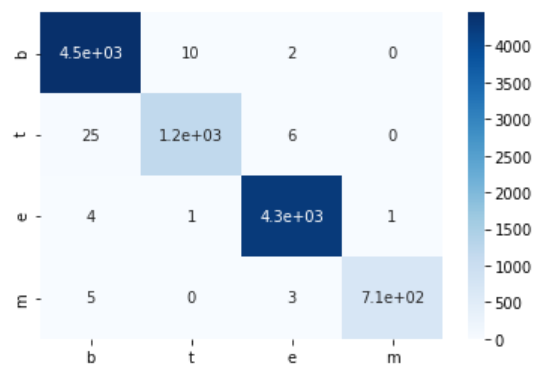
code
test_cm = confusion_matrix(test_x, test_t)
print('Evaluation data')
print(test_cm)
show_cm(test_cm)
output
Evaluation data
[[516 13 12 6]
[ 35 87 10 2]
[ 22 2 531 3]
[ 10 5 5 77]]
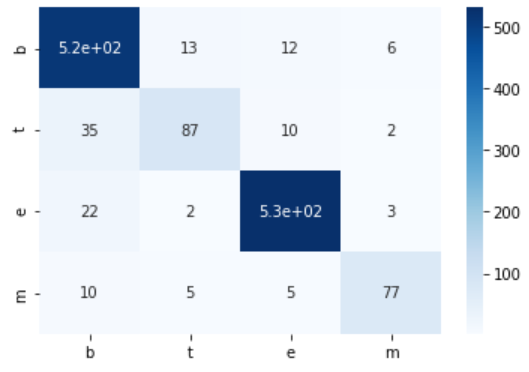
56. Measurement of precision, recall, F1 score
Measure the precision, recall, and F1 score of the logistic regression model learned in> 52 on the evaluation data. Obtain the precision rate, recall rate, and F1 score for each category, and integrate the performance for each category with the micro-average and macro-average.
There is a function that does the same processing in sklearn, but I am in a position to implement this by myself. Some tasks use the $ F_ {0.5} $ value, and I think it's better to write it yourself.
code
tp = test_cm.diagonal()
tn = test_cm.sum(axis=1) - tp
fp = test_cm.sum(axis=0) - tp
code
p = tp / (tp + tn)
r = tp / (tp + fp)
F = 2 * p * r / (p + r)
code
micro_p = tp.sum() / (tp + tn).sum()
micro_r = tp.sum() / (tp + fp).sum()
micro_F = 2 * micro_p * micro_r / (micro_p + micro_r)
micro_ave = np.array([micro_p, micro_r, micro_F])
code
macro_p = p.mean()
macro_r = r.mean()
macro_F = 2 * macro_p * macro_r / (macro_p + macro_r)
macro_ave = np.array([macro_p, macro_r, macro_F])
code
table = np.array([p, r, F]).T
table = np.vstack([table, micro_ave, macro_ave])
pd.DataFrame(
table,
index = categories + ['Micro average'] + ['Macro mean'],
columns = ['Recall', 'Compliance rate', 'F1 score'])
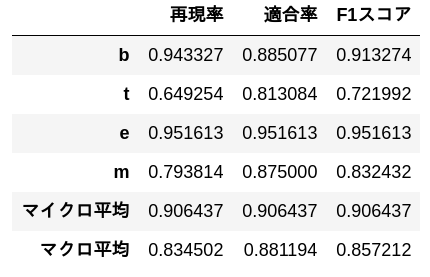
57. Confirmation of feature weights
Check the top 10 features with high weights and the top 10 features with low weights in the logistic regression model learned in> 52.
code
def show_weight(directional, N):
for i, cat in enumerate(categories):
indices = lr.coef_[i].argsort()[::directional][:N]
best = np.array(features)[indices]
weight = lr.coef_[i][indices]
print(category_names[i])
display(pd.DataFrame([best, weight], index = ['Feature value', 'weight'], columns = np.arange(N) + 1))
Top 10 features with large weight
code
show_weight(-1, 10)
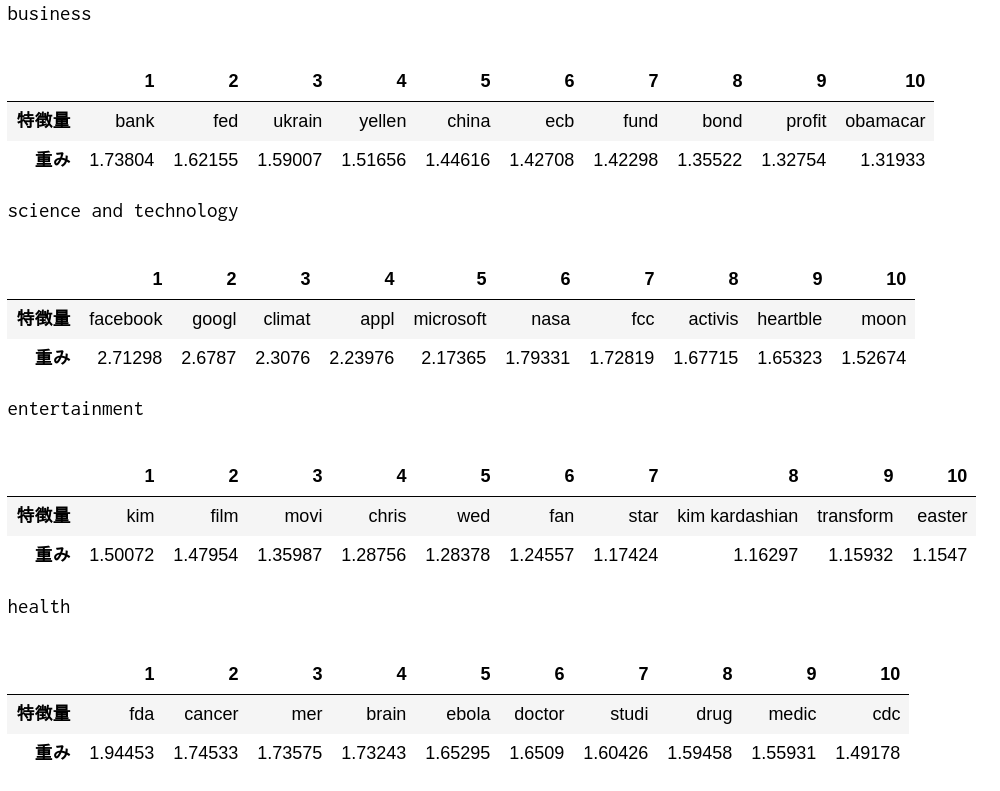
code
show_weight(1, 10)
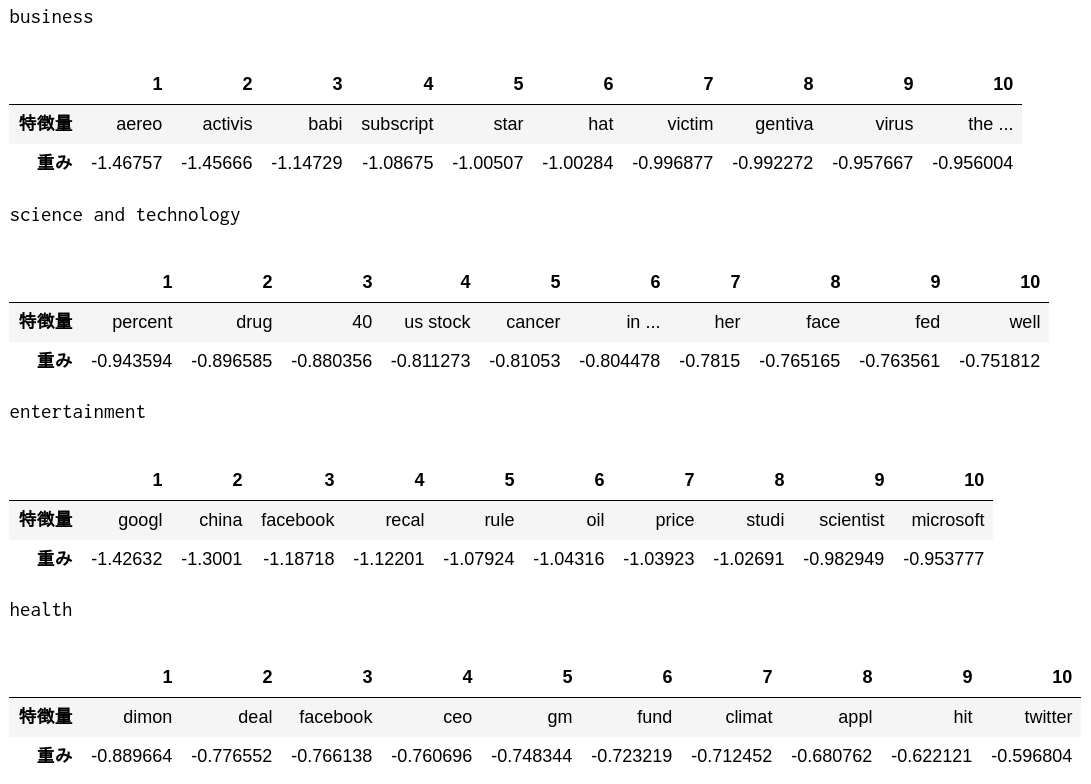
It seems that such features have been extracted.
58. Change regularization parameters
When training a logistic regression model, the degree of overfitting during learning can be controlled by adjusting the regularization parameters. Learn the logistic regression model with different regularization parameters and find the accuracy rate on the training data, validation data, and evaluation data. Summarize the results of the experiment in a graph with the regularization parameters on the horizontal axis and the accuracy rate on the vertical axis.
code
import matplotlib.pyplot as plt
import japanize_matplotlib
from tqdm import tqdm
Since it takes time, monitor with tqdm.tqdm.
code
Cs = np.arange(0.1, 5.1, 0.1)
lrs = [LogisticRegression(C=C, max_iter=1000).fit(train_x, train_t) for C in tqdm(Cs)]
code
train_accs = [accuracy(lr, train_x, train_t) for lr in lrs]
valid_accs = [accuracy(lr, valid_x, valid_t) for lr in lrs]
test_accs = [accuracy(lr, test_x, test_t) for lr in lrs]
code
plt.plot(Cs, train_accs, label = 'Learning')
plt.plot(Cs, valid_accs, label = 'Verification')
plt.plot(Cs, test_accs, label = 'Evaluation')
plt.legend()
plt.show()
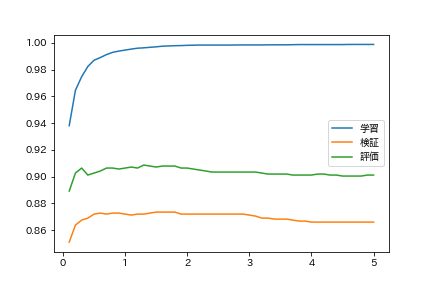
You are overfitting when regularization is weak.
59. Searching for hyperparameters
Learn the categorization model while changing the learning algorithm and learning parameters. Find the learning algorithm / parameter that gives the highest accuracy rate on the evaluation data.
Let's change the censoring error.
code
tols = np.logspace(0, 2, 50)
lrs = [LogisticRegression(tol=tol, max_iter=1000).fit(train_x, train_t) for tol in tqdm(tols)]
code
train_accs = [accuracy(lr, train_x, train_t) for lr in lrs]
valid_accs = [accuracy(lr, valid_x, valid_t) for lr in lrs]
test_accs = [accuracy(lr, test_x, test_t) for lr in lrs]
code
plt.plot(tols, train_accs, label = 'Learning')
plt.plot(tols, valid_accs, label = 'Verification')
plt.plot(tols, test_accs, label = 'Evaluation')
plt.xscale('log')
plt.legend()
plt.show()
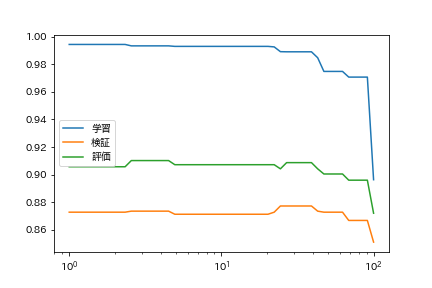
I would like to try other than logistic regression.
So, looking at sklearn's famous flowchart, I feel like something is wrong.

Naive bayes
code
from sklearn.naive_bayes import MultinomialNB
code
nb = MultinomialNB()
nb.fit(train_x, train_t)
output
MultinomialNB(alpha=1.0, class_prior=None, fit_prior=True)
code
accuracy(nb, train_x, train_t)
output
0.9429988768251591
code
accuracy(nb, test_x, test_t)
output
0.8907185628742516
Text classification COSPA strongest naive bayes
Linear support vector machine
code
from sklearn.svm import LinearSVC
code
svc = LinearSVC(C=0.1)
svc.fit(train_x,train_t)
output
LinearSVC(C=0.1, class_weight=None, dual=True, fit_intercept=True,
intercept_scaling=1, loss='squared_hinge', max_iter=1000,
multi_class='ovr', penalty='l2', random_state=None, tol=0.0001,
verbose=0)
code
accuracy(svc, train_x, train_t)
output
0.9908274054661176
code
accuracy(svc, test_x, test_t)
output
0.9041916167664671
It's very good.
Next is Chapter 7
Language processing 100 knocks 2020 Chapter 7: Word vector
Recommended Posts